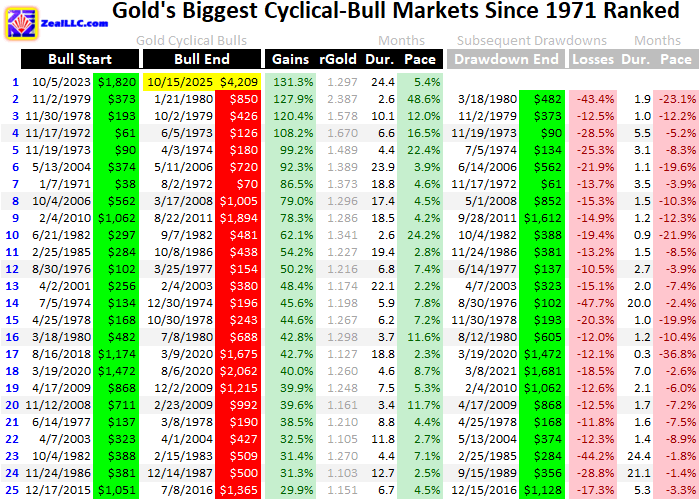Gold’s Biggest Bull Ever!
Gold’s mighty cyclical bull just grew into its biggest ever! Midweek gold’s massive bull over these past couple years eclipsed its famous popular speculative mania into January 1980. This is truly a stunning achievement, both exciting and concerning. Gold’s relentless upside momentum is bullishly attracting in legions of new speculators and investors. Yet gold’s powerful surge has also left it exceedingly-overbought.
Discussing gold’s biggest bulls ever requires some qualifiers. There are two kinds of bull markets, longer secular and shorter cyclical ones. Broader secular bulls are comprised of series of smaller cyclical bulls and bears. Defining secular bulls is somewhat-subjective. For example, plenty of analysts consider the entire 1970s one humongous secular bull. Gold skyrocketed 2,155% over 9.0 years into January 1980.
But smack in the middle of that from December 1974 to August 1976, gold cratered a horrendous 47.7% in 1.7 years! That sure wasn’t very bull-like. So I’d argue the 1970s had two separate secular bulls, a 419% one over 4.0 years into December 1974 then a second 732% monster over another 3.4 years cresting in that same January-1980 parabolic blowoff. But smaller cyclical bulls are hard-defined and not disputable.
When gold rallies 20%+ on a closing basis, that entire up move retroactively and formally is classified as a cyclical bull. Cyclical bulls persist until gold falls 10%+ on a closing basis from its bull high. Through that entire 1970s decade, gold enjoyed nine separate cyclical bulls averaging 80.1% gains over 7.8 months each! This essay deals solely in gold’s cyclical bulls in US-dollar terms since 1971, a landmark year.
Before 1934, the US dollar was on a gold standard legally pegged near $21 per ounce. In January that year, Franklin Roosevelt devalued that statutory gold price to $35. That dollar-gold price was formalized internationally in the 1950s in the Bretton Woods system, and lasted until Richard Nixon formally severed the US dollar from gold in August 1971. That notorious devaluation is when free-market dollar-gold prices were born.
So gold’s biggest bulls ever mean US-dollar cyclical ones since 1971. That is a super-long half-century-plus span of 54.8 years. I suspect very few reading this have been investing that long, and odds are the majority of readers weren’t even born yet in January 1971. I wasn’t, entering this world later in the mid-1970s. As my father was a banker who watched markets, I remember him talking about gold when I was little.
As gold soared this year, I analyzed every 10%+ gold move on a closing basis in each direction since January 1971. It turns out there have been 83 of them. Up moves between 10% to 20% are classified as uplegs, and 20%+ as cyclical bulls. Subsequent down moves are corrections between 10% to 20%, and bear markets beyond 20%. Again cyclical bulls and cyclical bears persist until 10%+ countermoves end them.
Gold’s current mighty cyclical bull was born in early October 2023 near $1,820 per ounce. As of this Wednesday’s $4,209 close, gold has soared a phenomenal 131.3% in the 24.4 months since! That is its biggest cyclical bull on record, besting January 1980’s climax up 127.9% in just 2.6 months! While my spreadsheet is big and complex slicing up all gold’s 10%+ moves in multiple ways, here are its top bulls ranked.
This table is pretty straightforward, with each bull’s starting date and price, ending date and price, and ultimate closing gains listed. That’s followed by an overboughtness measure called rGold, which looks at gold relative to its trailing 200-day moving average. Then each gold bull’s duration in months is shown, followed by its gains’ monthly pace. Both rGold and monthly pace illuminate how extreme bulls became.
Those cyclical-gold-bull stats are then followed by how gold fared in the aftermaths of those mighty bulls, the immediate subsequent drawdowns. Those selloffs’ end dates and gold prices are noted, along with gold’s total losses, their duration in months, and their monthly pace. Powerful cyclical gold bulls are always, literally 100% of the time, followed by sizable-to-massive selloffs! Today’s bull won’t prove an exception.
We’ve all had people tell us they have good news and bad news, then ask which we want to hear first. I’ve always wanted to know the worst up front. Once I know what the problems are, I can think and adapt and try to overcome them. So we’ll start with the concerning aspects of this colossal gold bull before the exciting ones. Today’s Relative Gold overboughtness situation is dangerously extreme, portending a big selloff.
If you want a far-more-thorough discussion about rGold and how it works, about a month ago I wrote an essay on gold being pretty stretched technically. When I penned that, gold had just surged 18.5% above its 200dma baseline. But that was nothing compared to the 29.7% over gold hit this Wednesday! Those are among gold’s most-extreme overbought levels seen in the past 55 years. Past extremes were ominous omens.
While market history never repeats exactly, it certainly rhymes. Although markets change, the greed and fear in traders’ hearts and their resulting herd behavior never does. Traders love flooding into hot assets to chase upside momentum, which accelerates it. As prices surge, greed grows excessive morphing into euphoria. But sooner or later that sucks in all-available near-term buyers, then fueling capital inflows dry up.
Once buyers exhaust their capital firepower for chasing, only sellers remain. Their capital outflows soon hammer extremely-overbought prices sharply lower, scaring recent buyers. They frantically flee greatly upping cascading selling pressure. So the recently-hot prices rapidly collapse. This inevitable pattern happens as every mighty bull crests, from mega-cap-tech stocks to silver to bitcoin to the US Dollar Index.
This week’s 1.297x rGold read is the highest since May 2006. That last time gold was so extremely-overbought 19.4 years ago capped gold’s 6th-largest bull that saw 92.3% gains over a similar-to-today 23.9 months. Both are powerful slow-burn gold bulls, more-gradual ascents which really improve gold’s staying power and lower risks for serious selloffs. Yet right after that bull peaked, gold still suffered one anyway.
Over the next 1.1 months into June 2006, gold plummeted 21.9%! I remember that 2006 bull and bear well, as I started intensely studying and actively trading gold stocks and explaining all that in our popular financial newsletters way back in 2000. The herd greed, euphoria, and enthusiasm for gold in May 2006 was quite similar to today’s. Everyone loved gold, as Wall Street analysts forecast way-higher prices.
Interestingly gold’s big-and-fast subsequent drawdown the last time it got this overbought is pretty typical for mighty bulls. With today’s being gold’s largest ever, consider the next-ten-biggest. They averaged 90.8% gains over 12.4 months, peaking at average rGold levels of 1.504x. Realize the latter is skewed high by January 1980’s popular-speculative-mania parabolic blowoff, which peaked at an insane 2.387x!
Without that, the next-nine-largest gold bulls averaged cresting 40.5% above gold’s 200dma. Scarily gold’s average drawdown after the next-ten-largest was 20.8% over 2.1 months. Taking out the January 1980 moonshot doesn’t change that much, leaving the next-nine-largest averaging 18.3% in 2.1 months. Heck the next-24-largest gold bulls in this table averaged subsequent 20.2% drawdowns over 4.7 months.
So 20%ish bear-market-grade selloffs after mighty gold bulls are par for the course, certainly highly-probable! At this Wednesday’s data cutoff for this essay, a 20% selloff would hammer gold way back down to $3,367. As that level was first seen in mid-April 2025, it really wouldn’t be a big deal in the grand scheme. But that would obliterate popular gold euphoria, leaving recent buyers weeping and gnashing teeth.
A bigger concern in a 20% gold drawdown is gold stocks. Last week I wrote an essay analyzing gold miners’ imminent epic record Q3 earnings season. Last quarter will prove gold miners’ ninth in a row of stupendous stock-market-leading earnings growth averaging about 72% year-over-year! The gold miners are earning money hand-over-fist in this windfall super-high-gold environment, gold stocks are phenomenal.
In our subscription newsletters since 2000, as of Q3 we’ve closed 1,601 mostly-gold-stock trades averaging fantastic 18.2% annualized realized gains! That’s about double stock markets’ long-term average. We still have another 20 open gold-stock trades in our newsletters with unrealized gains running as high as +153% midweek! And the large majority of these trades are young, added from late June to late July.
You’d truly be hard-pressed to find a bigger gold-stock enthusiast than me, or someone with a longer or more-profitable public gold-stock trading record. Gold stocks are awesome because their profits really leverage gold’s underlying moves. But that’s a double-edged sword, cutting both ways. Historically when gold suffers material selloffs, leading gold-stock benchmarks amplify gold’s downside by at least 2x to 3x.
So if gold is in for a 20% bear-grade drawdown once its biggest bull ever inevitably crests, the major gold stocks dominating the popular GDX gold-stock ETF will almost certainly collapse 40% to 60%! Losses on that scale are catastrophic, especially for older speculators and investors. So for gold-stock traders, a 20% gold selloff is a dire threat. That’s why we’ve ratcheted up trailing stop losses on all our open trades.
Because gold is so exceedingly-overbought, so are gold stocks which have amplified their metal’s strong gains. Midweek GDX soared to 58.0% above its own 200dma! In the entire history of this dominant gold-stock ETF since its 200dma was first established in March 2007, 1.58x+ rGDX levels have only happened on ten trading days or 0.2% of the total. The biggest cluster by far was fully seven stuffed into July 2016.
Gold’s upleg peaking then sure wasn’t extreme by top-25 standards, ranking dead-last at 25th with mere 29.9% gains to comparatively-modest 1.151x rGold levels. Yet gold’s selloff after that bull was still 17.3% in 5.3 months. How did GDX fare in that exact span? It still dropped an ugly 37.8%, which was mild at 2.2x gold’s drawdown. The point is if gold soon sells off 10%+ or 20%ish, gold stocks are going to plunge hard.
So gold likely staring down both barrels of a 20%ish drawdown is the bad news. The good news is that its broader secular bull probably isn’t over yet. The most-bullish fundamental argument for gold is that investors remain way-underallocated in it. Bank of America does a monthly survey including about 400 professional fund managers from institutions, mutual funds, and hedge funds. The latest edition just came out.
Those elite fund managers reported average gold allocations near a paltry 2.4%! That is still next to nothing. There’s another metric I like implying American stock investors’ gold allocations. It simply looks at the ratio between the value of the gold-bullion holdings of the dominant GLD, IAU, and GLDM gold ETFs to the market capitalization of all S&P 500 stocks. The latter is now running an astounding $60,144b.
Yet even with these lofty record gold prices, midweek the combined holdings of GLD+IAU+GLDM were only worth $228b. That implies American stock investors’ gold allocations are still running under 0.4%, which rounds to zero! For over a quarter-century now, I’ve argued all investors should have 5% to 10% of their investable assets in gold. Two weeks ago on CNBC, a famous billionaire hedge-fund manager said 15%!
Because investors’ gold allocations are so darned low, this broader secular gold bull ought to continue higher on balance for years to come. But a rebalancing selloff is necessary before that to normalize gold’s extreme technicals and greedy sentiment. And despite being gold’s biggest bull ever, today’s epic monster is much-less-extreme than past big gold bulls. In rGold terms, midweek’s 1.297x only ranks as 9th-highest.
As I was a little kid in January 1980, I don’t remember gold’s popular speculative mania and parabolic topping then. But today’s gold bull is nothing like that statistically. That 127.9% superspike happened in just 2.6 months, skyrocketing at a blistering 48.6% monthly place! In my extensive studies of market history, I’ve found that anything doubling in about several months is a popular speculative mania going terminal.
In these last three months since mid-July 2025, today’s gold bull is only up 26.5%. The most-encouraging thing about this record gold bull is its slow pace overall. Since its birth in early October 2023, gold has only averaged a pace of 5.4% monthly gains. Out of all 42 cyclical gold bulls since 1971, that only ranks as 23rd! While today’s gold bull is colossal in size, when gains are considered over duration it is actually middling.
So in cyclical-bull terms, gold is exceedingly-overbought and overdue for a big-and-fast 20% drawdown. Yet in broader secular-bull terms, gold likely has lots of gains left in its tank after gradually powering higher for a long time in fairly-conservative fashion. If you are an unleveraged gold investor, a 20%ish selloff might not worry you too much. But if you are deployed in gold stocks, you are looking at 2x to 3x gold’s losses.
And realize today’s freakishly-huge gold cyclical bull is a real anomaly. Three separate times since its birth in early October 2023, gold has surged well into extremely-overbought territory. Yet instead of seeing 10%+ corrections as usual after those episodes, gold consolidated high. Those multi-month sideways drifts rebalanced technicals and sentiment, but much more slowly than corrections while including pullbacks.
Pullbacks are sub-10% selloffs. In early May 2025, gold plunged 7.1% in just over a week. Its biggest selloff of this mighty cyclical bull was another 8.0% pullback into mid-November 2024. With just another few days of selling, either of those could easily have reached 10%+ correction status. The latter would’ve split today’s mighty gold bull into two, the first half up about 53% and the second half to today around 64%.
Both still would’ve been big by gold-cyclical-bull standards since 1971, but they would’ve just ranked as 12th and 10th largest. Had that been the case with just a slightly-bigger selloff hitting correction-grade, no one would be talking about gold’s biggest bull ever. So while I’m short-term-bearish on gold way up at such crazy-extreme overboughtness, I’d be shocked if gold doesn’t subsequently rally way higher in coming years.
What to do? Most importantly don’t succumb to this herd greed and add gold and gold stocks way up at these precarious record highs. Chasing extremes always ends badly for those foolish enough to do it! If you have existing positions, either implement or tighten trailing stop losses to protect the great majority of your unrealized gains. Big-and-fast selloffs are perfectly normal after cyclical bulls and within secular bulls.
Successful trading demands always staying informed on markets, to understand opportunities as they arise. We can help! For decades we’ve published popular weekly and monthly newsletters focused on contrarian speculation and investment. They draw on my vast experience, knowledge, wisdom, and ongoing research to explain what’s going on in the markets, why, and how to trade them with specific stocks.
Our holistic integrated contrarian approach has proven very successful, and you can reap the benefits for only $10 an issue. We extensively research gold and silver miners to find cheap fundamentally-superior mid-tiers and juniors with outsized upside potential. Sign up for free e-mail notifications when we publish new content. Even better, subscribe today to our acclaimed newsletters and start growing smarter and richer!
The bottom line is gold just achieved its biggest cyclical bull ever! Gold’s total gains through these last couple years have now eclipsed its terminal superspike’s into January 1980. But while gold has soared deep into extremely-overbought territory, overall this bull is way-milder. It merely ranks 9th out of all cyclical bulls since 1971 in overboughtness, and just 23rd in its monthly-ascent pace. This gold bull is measured.
While extreme, this is no popular speculative mania climaxing a long secular bull. Gold certainly does need to sell off hard and fast soon to rebalance way-overextended technicals and sentiment. History argues a 20%ish drawdown is probable, which gold stocks will leverage 2x to 3x like usual. But after that, gold’s broader secular bull should continue powering higher on balance as investors up their low gold allocations.
*********

















